
Aglaia Kremezi’s report
(with Costas Moraitis’ invaluable help and editing)
Walking on Longwall Street towards St. Catz’ on Friday afternoon felt so familiar and pleasant as if less than a few months, not three whole years had passed since I was last surrounded by these imposing medieval buildings. It was my first real trip abroad after more than two years of confinement on Kea, the Greek island where my husband and I live permanently for over twenty years, and I was immensely looking forward to it.
As we assembled for our first live session in the auditorium, after three years of online meetings, the chair Elisabeth Luard welcomed us, and the Symposium officially began with Corby Kummer’s keynote speech ‘Fast Foods: Past, Present and Future.’ Unfortunately, it was delivered via Zoom on the big screen. I was so much looking forward to seeing my old friend after more than three years, but he decided not to cross the Atlantic after all. Corby is the author of The Pleasures of Slow Food, the first book in English on the Slow Food movement that started in Italy when Mc Donald’s opened the first restaurant in Rome’s Piazza Navona. After confessing that he has never eaten a fast-food meal, he surprised us as he enthusiastically quoted professor Marcia Chatelain’s ‘Franchise: The Golden Arches in Black America,’ whichexplained howthe franchising of fast-food restaurants by black citizens in their own neighborhoods has improved the quality of black lives. The much-vilified fast-food chain even granted loans to first-time entrepreneurs helping them to build their own restaurants which allowed black American families to sit with dignity and enjoy an affordable meal in many underprivileged neighborhoods, Kummer said. Of course, the owners of the multibillion-dollar companies did not become suddenly sensitive to social injustice and the terrible abuses of US society; they just cared about profit, as they did when they recently decided to only use ‘cage-free eggs’ in all their dishes, Kummer explained. But this decision will hopefully inspire other fast-food companies to care more about the treatment of animals and the environment, he said, emphasizing that he is an optimist. The brilliant Marion Nestle, who took part in the lively online discussion —hosted by Elisabeth Luard— said that for her the ‘cage-free’ definition was just a gimmick; she wasn’t even sure what it actually meant. Our old friend Marion, the renowned professor and food activist, is not an optimist; and I’m afraid neither were most of us in the audience…

Brexit has made Ursula Heinzelmann’s life a lot more difficult, as she compiles her famous, dazzling, wine lists for us to savor before and during the meals. But she did manage to get us some great wines yet again! A lovely bubbly Brazilian Cuvee Tradition Brut NV Miolo, from Sierra Gaúcha was served at the first reception in the garden, and we sipped it while tasting sweet, creamy white corn bites, served on banana leaves, and crunchy popcorn with fresh shredded coconut.
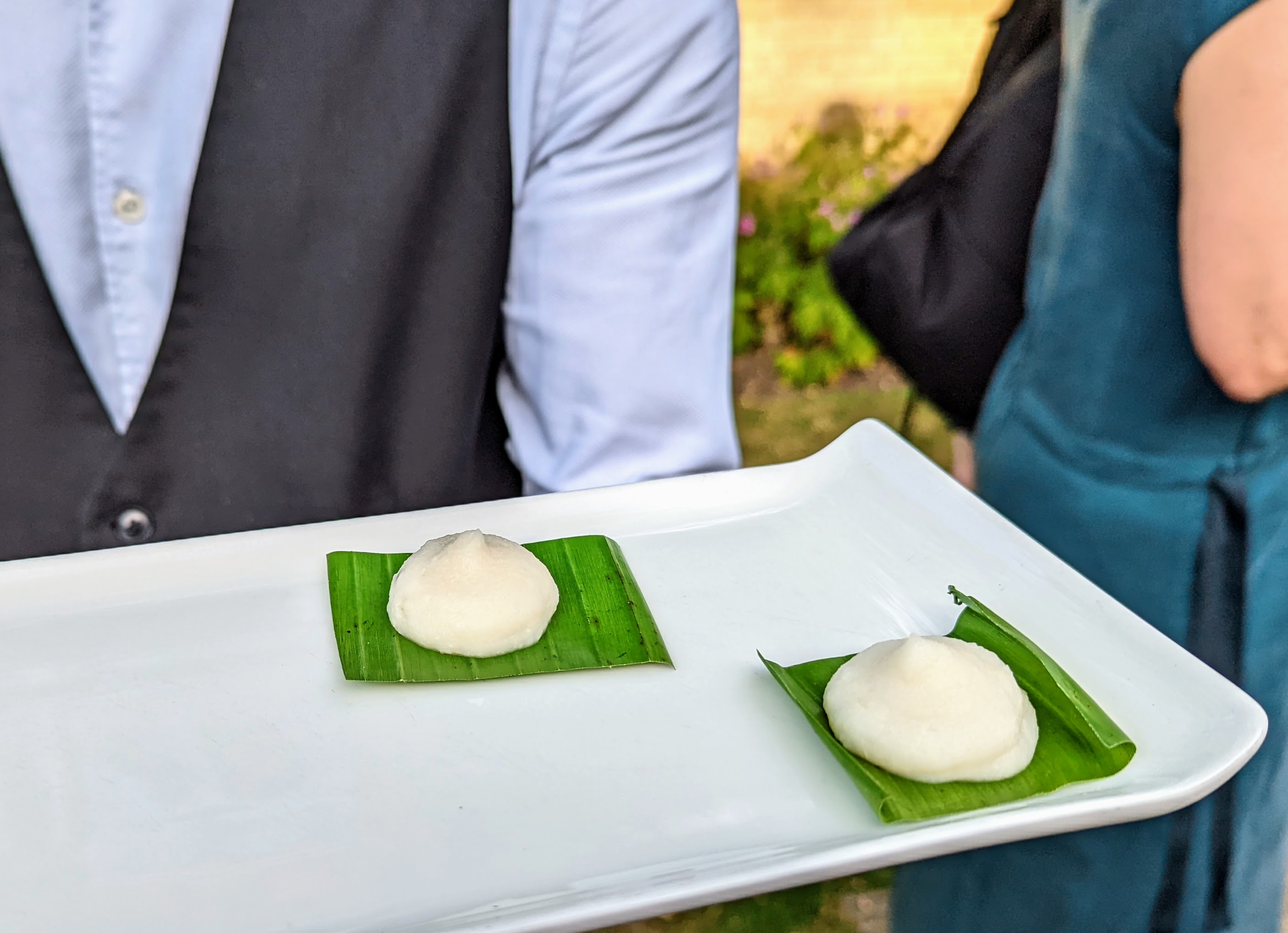
These bites were the opening for the glorious Feast of Afro-Brazilian Street Food, our first Symposium dinner, proposed and prepared by the brilliant Scott Alves Barton, and Marcia Zoladz.
We started with a Salad of Beetroot, Black-eyed Peas, and Palm Hearts, then had delicious Black-eyed Pea and Dried Shrimp Fritters accompanied by Cashew Nut Sauce, and Smoked Shrimp Salsa; the Tapioca Blinis with Shredded pork Sausage were a revelation, and the dinner concluded with traditional Brazilian Tropical Fruit Pastes, and a plate with Cassava and Coconut Cake complemented with Passion Fruit Sorbet.
The wines accompanying dinner were a 2020 Crasto White Quinta Do Crasto, from Douro/Portugal, and of course a lovely 2018 Kiedrich Turmberg dry Riesling, by Robert Weil from Rheingau/Germany. Desserts were accompanied by a wonderful Saudade from Dorli Muhr, Carnuntum/Austria!
Unfortunately, as always, I missed the after-dinner events –the Journey to Brazil, curated by Scott Alves Barton and Marcia Zoladz, and the Grand Bazaar of Portable Foods that Gamze Ineceli and Cathy Kaufman held at the Bar Annexe—as I can hardly keep my eyes open later than 9.30 pm…

SATURDAY’S KEYNOTE SPEAKER was the historian and author Lizzie Collingham who is “interested in linking the minutiae of daily life to the broad sweep of historical processes.” She completely charmed the audience with her witty, original, and beautifully illustrated paper ‘Portable Power: How the Industrial Ration Projected European Dominance Across the Globe.’ Talking about rusks, the hard biscuits which were the basic food of sailors, armies, and travelers for ages, she showed a photo of paximadia she shot in Greece; which brought me 26 years back to the 1996 Symposium whose theme was: Food on the Move, similar to this year’s. The paper I gave then on traditional Greek paximadia –the humble barley rusks—must have impressed Alan Davidson who chose to include the word and my description in his Oxford Companion to Food, thusputting paximadia on the international food map!
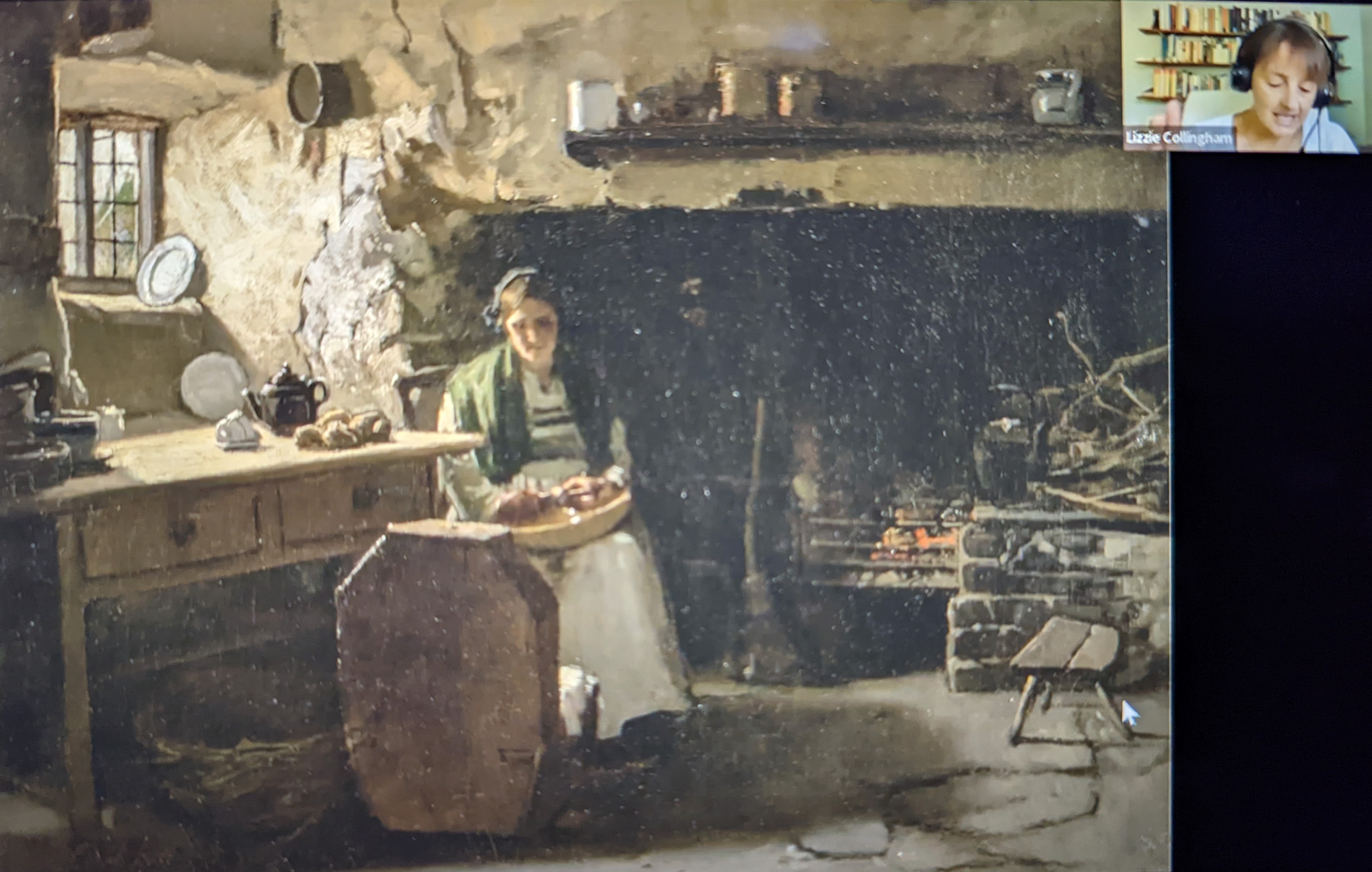
Lizzie’s colorful descriptions and fascinating observations about the way the British exploited whole populations with just tea and sugar –sometimes simply sugared water—was stunning. I felt that I had to listen again to her recorded online talk, and among the many things I learned was how the mediocre wine of Madeira became unique and desirable only because it was essentially spoiled and oxidized after its long passage across the seas.

THE VERY FIRST PANEL on Saturday morning at Oxford was about eating on trains: By Rail included the talk of Chloe Shields who deliberated on the introduction of posh restaurant compartments in the British Rail. Merry White and Voltaire Cang both described the past and present of the unique Ekiben, the elaborate bento boxes sold at various Japanese train stations. These ingeniously crafted boxes, often collector’s items, are usually quite affordable, it seems.
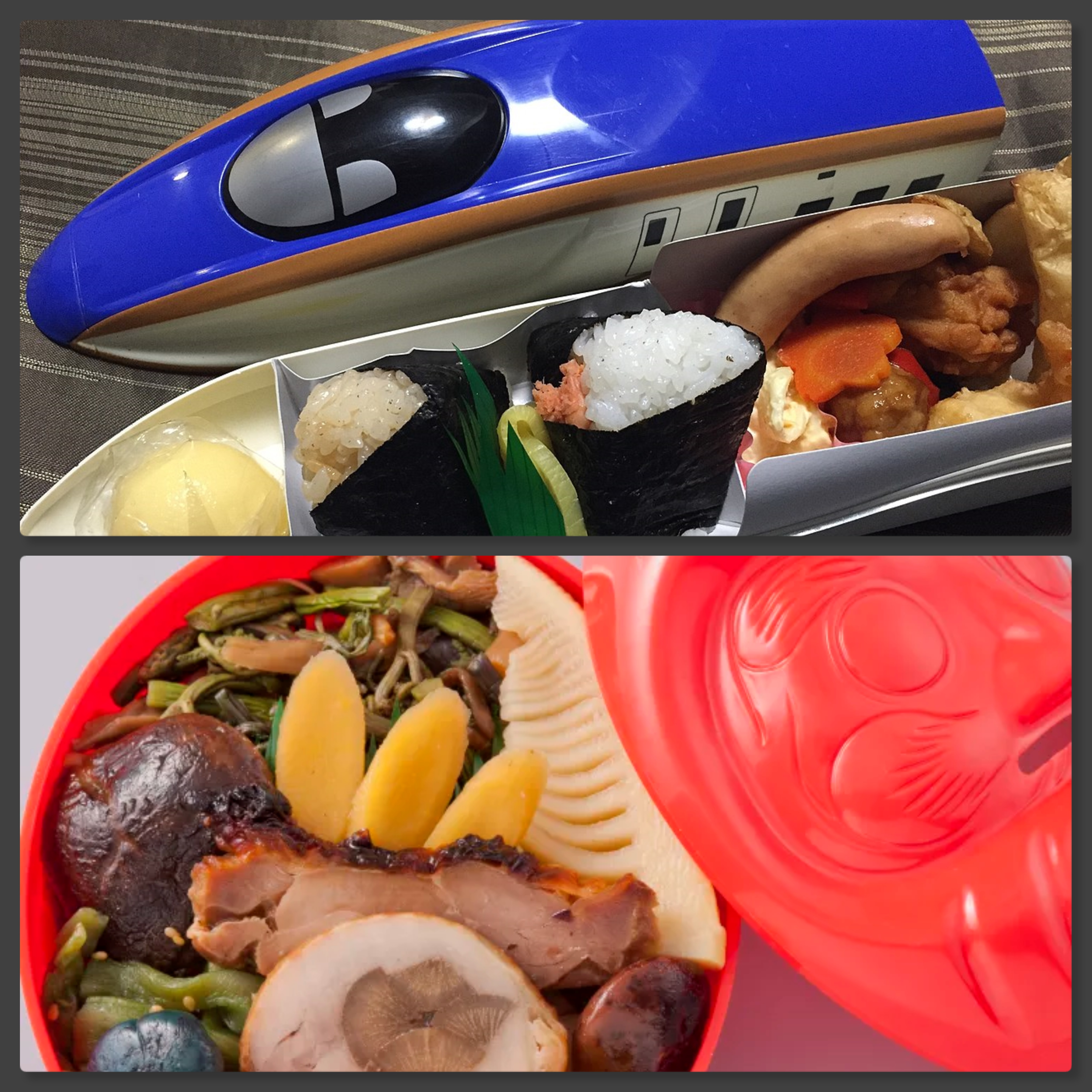
During the online session, which was masterfully hosted by the Symposium’s editor, Mark McWilliams, one more paper was added: Shirin Mehrota’s extremely interesting account on eating in the Indian trains. She spoke about how the meals consumed during the long train rides embodied and reproduced the various social habits surrounding food consumption in the context of caste, class, and gender. ‘Do people who meet in long train journeys sometimes share each other’s food?” Mark asked. “Never,” Mehrota responded!
THE SECOND PANEL ON SATURDAY MORNING was New Venues: Kashyapi Ghosh & V. Vamshi Krishna Reddy spoke about the phenomenon of mobile, portable vans run by amateur entrepreneurs who bring food to those who work in the financial and IT districts of India. Navreet Kaur Rana argued on the necessity of documenting the fading legacy of old-fashioned dhabas and safari-khana, two essential concepts of portable Indian food for long-distance travelers. On his part, Calum Young spoke about office meals and ‘sticky fingers on the keyboard.’ Besides serving the basic need for food, he said, the meal breaks sometimes function as a mental escape into privacy in one’s own personal world, away from the demanding tasks and the long hours on the desk. The live and online discussions were hosted by Naomi Duguid who is exceptionally knowledgeable about Asian foods and way of life. Asking the right questions she helped people like me, who know very little about the Indian food and customs, understand the first two papers which dealt with concepts I knew nothing about.
This year the conference had a two-sided element which I found wonderful. The live meetings during the weekend at St. Catz with some of the presenters who deliver their papers; and a week later, the extended list of pre-recorded presentations, and especially the truly engaging online discussions with each presenter about their papers which lasted all through July.
Note that, as always, a great part of the Symposium’s charm, both the live and the online one, at least in my opinion, is the often unexpected, whimsical grouping of the various papers by Cathy Kaufman, our ingenious programmer. She manages to find hidden threads that unite presentations which may seem unrelated, and thus helping to create engaging sessions.
JUST BEFORE LUNCH on Saturday, I was given the privilege to deliver at the plenary session my paper on Athenian picnics of the 60s to 70s. I spoke about my own memories describing the dishes we shared during our excursions –the word picnic not yet been part of our vernacular– and how they evolved when industrial foods were introduced in Greece. My paper became part of Rules for Picnics during the online discussions, hosted by Elisabeth Luard.
Elisabeth is one of the most knowledgeable people I have ever met. Her overall involvement to the live and online discussions –I don’t believe she missed any– is truly invaluable! We also appreciated her vivid, old and new sketches and watercolors of plants, sea and land creatures, and of course dishes, which helped us visualize the foods and ingredients we talked about.
Tanushree Bhowmik, a passionate Indian food researcher who, along with her husband, creates pop-up dinners, gave a very interesting account of the Gaudiya Vaishav religious food code. She listed, cooked, and photographed the various dishes included in the outdoor offerings to Krishna, suggesting that the list scholars who composed it reflected the 15th c. CE religious code but also included foods available in the area Krishna grew up. I especially appreciated Nader Mehravari’s paper. A Persian food historian at the University of California, Davis,Naderdescribed the various elements of outdoor eating: location, foods, paraphernalia, and equipment in Iran and Persianate societies. Picnics were and still are very popular in Iran, and can be held, besides parks, in many places, including cemeteries, parking lots, or even steep hillsides, he said, illustrating his talk with wonderful and intriguing photos.

Saturday Lunch was an inspired compilation of foods that the brilliant chef-activist Joshna Maharaj would have liked to serve at a hospital meal: Caldo Verde, Cheddar and Herb biscuit with Cucumber Salad, Chalk Stream Trout fillet with Lemon Butter Sauce –or Grilled Za’atar Courgettes (zucchini) for the vegetarians—accompanied by delicious Brown Rice Pilaf with French Beans, Sugar Peas, and Blackcurrant Vinaigrette. No wine, of course, but a refreshing Sweetgrass Infusion. The dessert was a lovely, classic Berry Trifle.
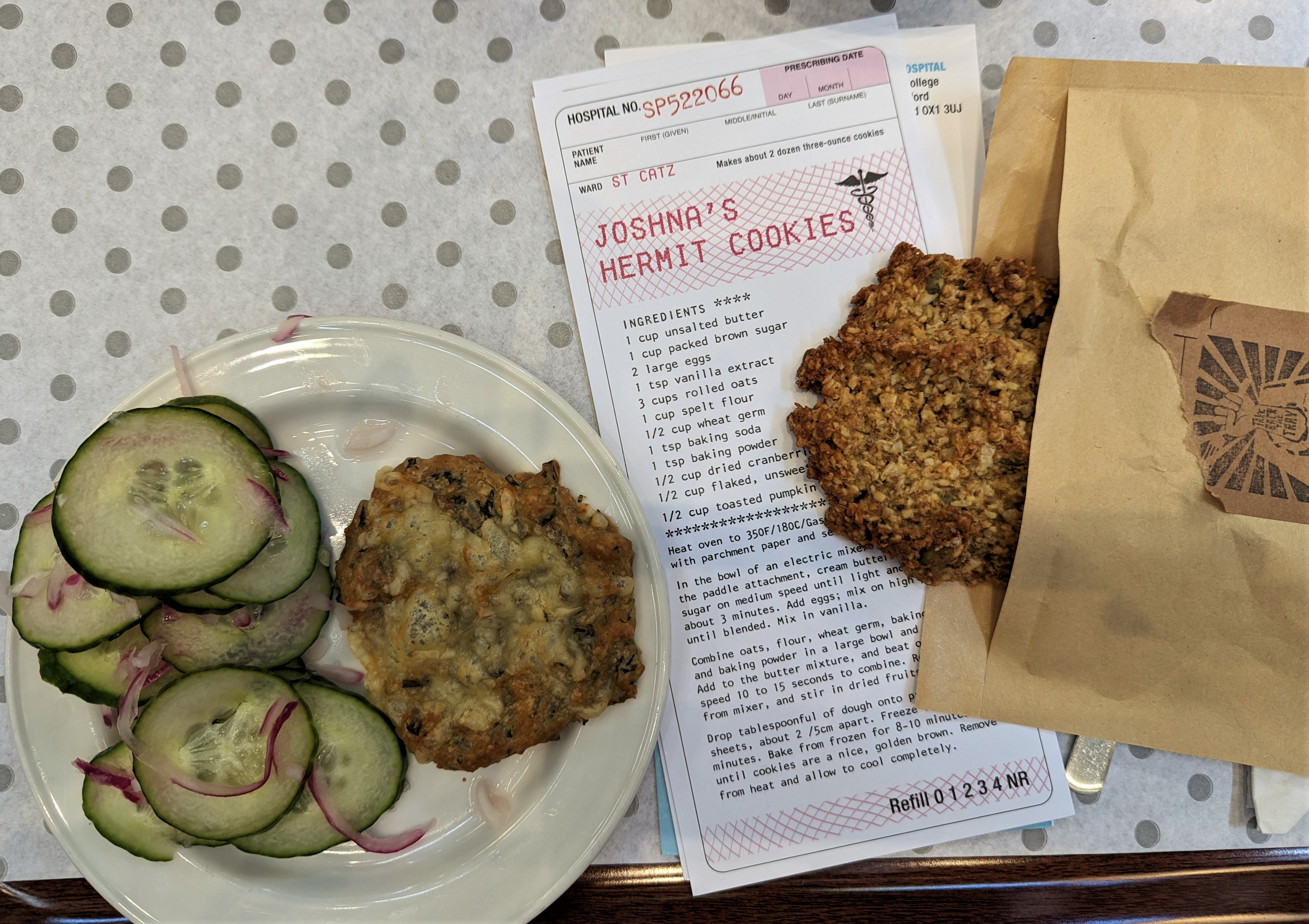
AN EXAMPLE OF OUR PROGRAMER’S CREATIVE GROUPING was Saturday afternoon’s first session at St. Catz BS Lecture Theater. Under the title The Vulnerable Laura Kitchings discussed the three phases in Paddington Bear’s marmalade sandwiches, first as an outsider in London, second as participant in the larger world, and third as a refugee in London. Else Marie Knudsen passionately described the junk food provided for visitors in Canadian prisons, as experienced by the certainly vulnerable families of the incarcerated. She focused on how the various, often insane restrictions of edible items affect the mostly poor families, especially children who share meals with imprisoned relatives. On the other hand, Janet Beizer spoke about the French aversion towards public eating through a fascinating, very detailed examination of Edouard Manet’s painting of a woman eating cherries on the street. The painting is called Street Singer, a term often used to characterize Paris prostitutes, Janet explained –certainly vulnerable persons in those days.
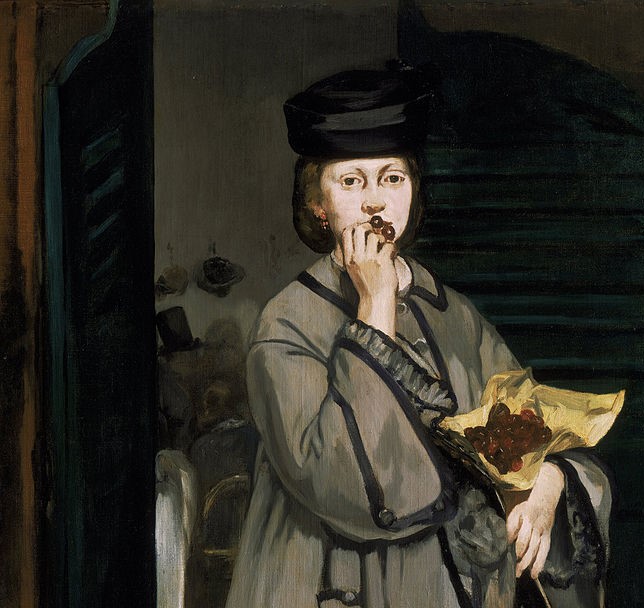
Eating in public was unacceptable and illegal in 19th c urban France, and as Beizer said, even today many French find appalling the idea of eating while walking on the street, as a taxi driver told her. A proper meal at the table is still something sacred in France, it seems.
Her brilliant talk was moved to a different, more suitable group for the online session, becoming part of Transgressive Eating in Public, along withNattha Chuenwattana & Chonlatorn Wongrussame’s paper that discussed raw portable food as a symbol of defiance during the political demonstrations organized by Thailand’s opposition against the government, and Joshua Lovinger’s analyses of the controversial history of market/street eating during classical times. I have my doubts about his statement that ancient Greeks in general considered eating in public disgusting, especially his use of Diogenes, ‘the Dog,’ as an example. But as always, Joshua’s paper was captivating as he listed the attitudes of many civilizations and tribes and compared them with today’s claims about the authenticity of street food.
Janet Beizer’s extended Q & A session during the live session at Oxford was exceptionally interesting; somebody even suggested that maybe the cherries in the painting have a sexual connotation. The online discussion of all three papers, hosted by Scott Barton, was equally captivating. The audience seemed to be especially intrigued by Nattha Chuenwattana’s descriptions of the bloody raw meat consumed during the Thailand demonstrations.
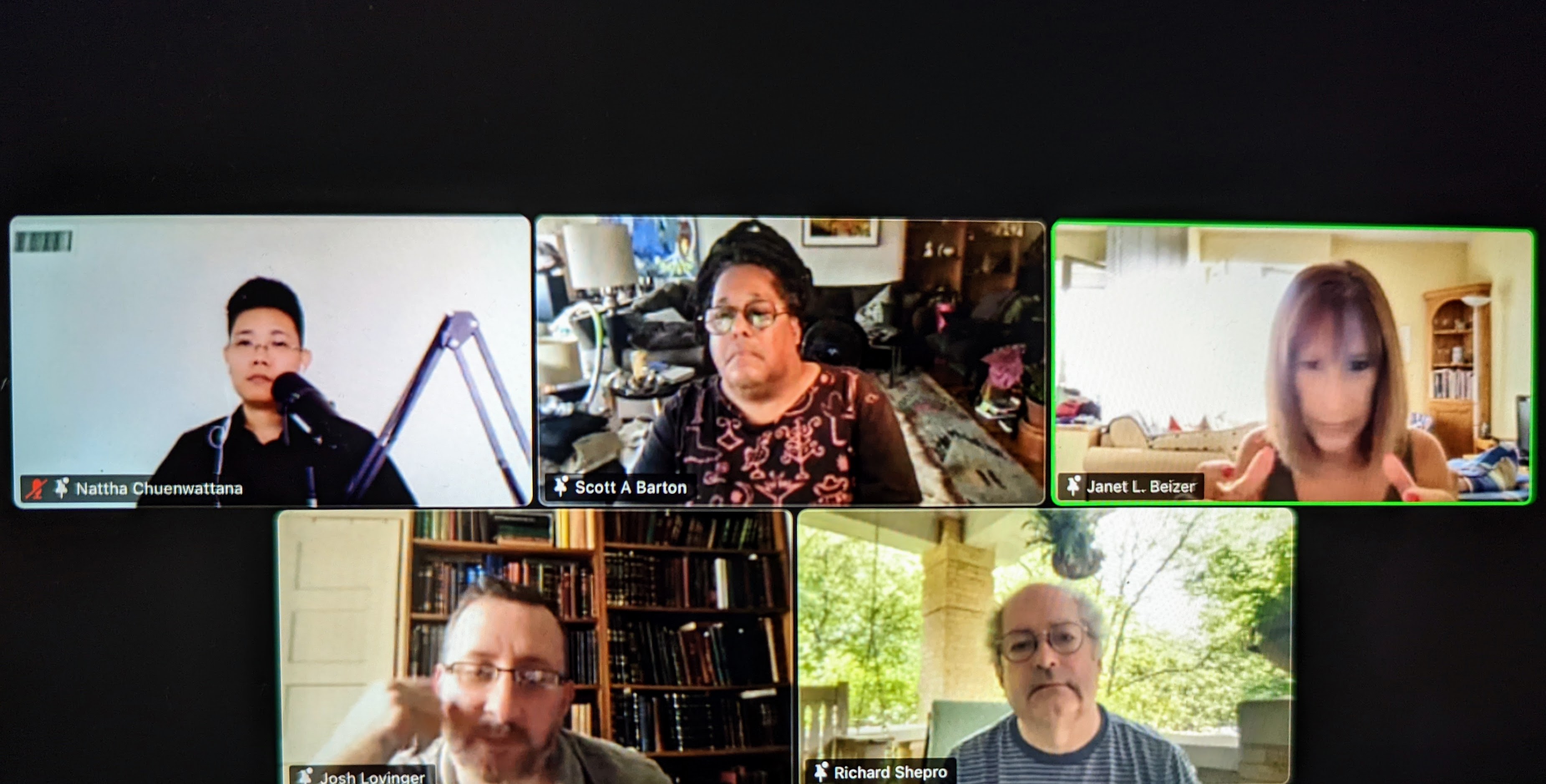
SATURDAY AFTERNOON’S SECOND, PARALLEL SESSION was Preserved for Travel: Kathleen Burke analyzed the movement of the iconic Dutch East Indian achar, a preparation she argues has its roots in the littoral societies of Indonesia, based on the region’s food preservation techniques, the mobility of material culture and labor, along with colonial ideas about healthy diet. Simi Rezai-Ghassemi focused on qurut or kashk, the dehydrated, rock-hard yogurt balls, a staple of pastoral Turko-Mongolian peoples, which due to its convenient simplicity and nutritious value has now conquered outer space, becoming part of the supplies for the cosmonauts taking off from Baikonur! Simi brought with her gurut in various stages of dehydration, and she gave us a taste during the break in the garden.
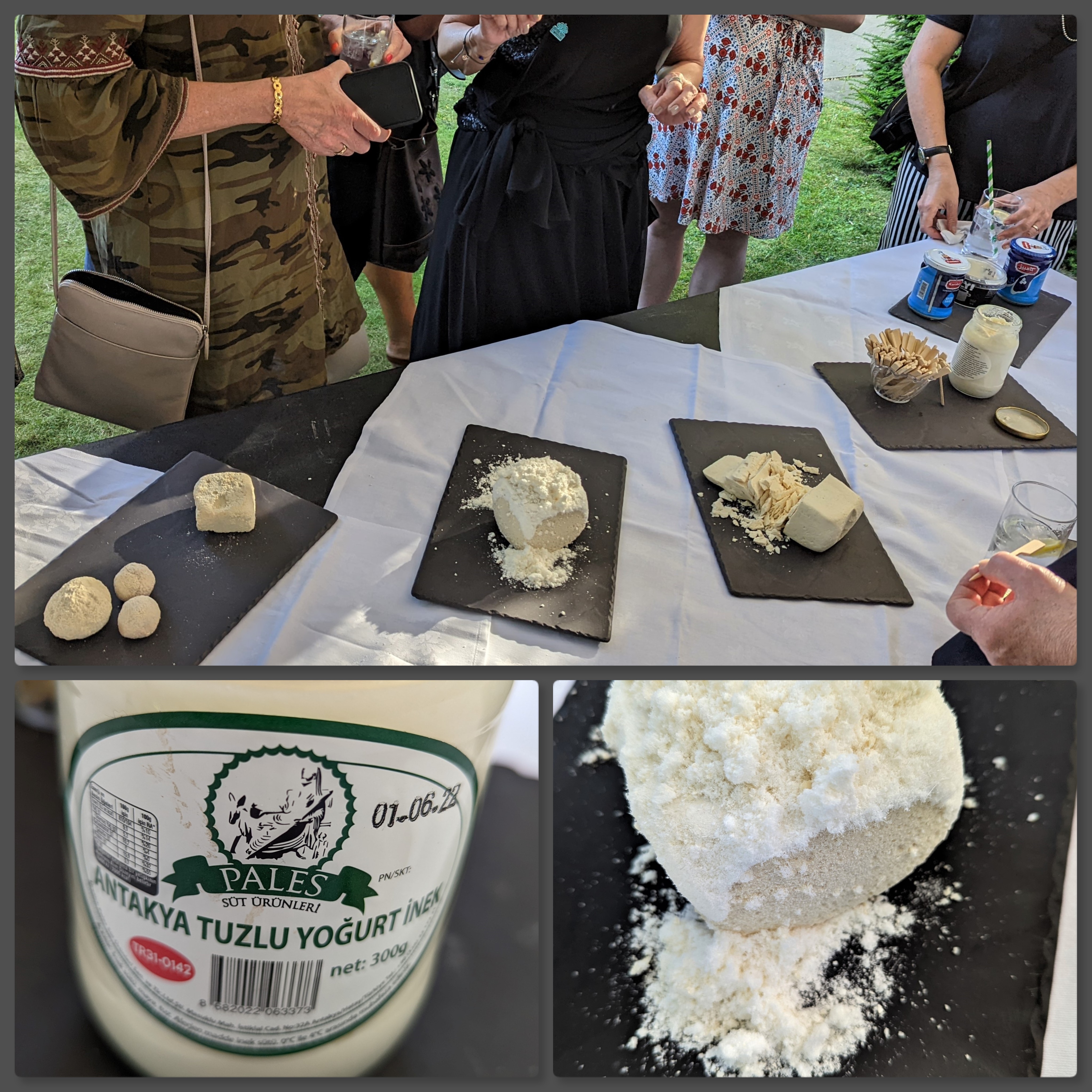
Sevgi Mutlu Sirakova discussed foods carried by today’s immigrants during their international relocations and she focused on the example of tarhana, the iconic fermented ‘pasta’ of the Eastern Mediterranean. It continues to be an important staple for the Turkish immigrants in Germany and other parts of Europe, she said. During the online discussion, hosted by Liz Wilding I expressed my regret that Americans and most northern Europeans were missing a lot as they have probably never tasted either gurut or tarhana —trahana and ksinohodro, in Greek, kishk in Lebanon— these ancient frugal staples prepared with grains and dairy. But then, I realized, I was equally sorry that I had never tasted an authentic achar!
THE FIRST OF THE LAST TWO PARALLEL SESSIONS LATER ON SATURDAY afternoon was Carry in Style, hosted by Cathy Kaufman. Jesse Dart discussed lunchboxes and brown bags, the packaging in which foods are enclosed for transport, examining their cultural significance, and their diminished importance in today’s increasing takeaway options. Egyptian archaeologist Mennat-Allah El Dorry focused on tiffins, the wonderful multi-tiered metal food boxes from Northern Africa and the Middle East. She presented archeological, historic, and etymological evidence as a first step toward compiling their history. I was particularly fascinated to hear that these tiffins passed from one generation to the next, and their owners sometimes had their names inscribed on their ornate surfaces, allowing researchers to trace a tiffin’s provenance often to very faraway lands.
Carolyn Tillie reviewed the growth in popularity of travel equipage and the precious cutlery carried by British high ranking army personnel from the 18th c to the Belle Epoque. She has collected a fair number over the years from antique fairs, and during the online discussion she showed us many gorgeous examples, the result of advancing metallurgy techniques, as she explained. Some clearly seemed to be precursors to the famous Swiss Army Knife!
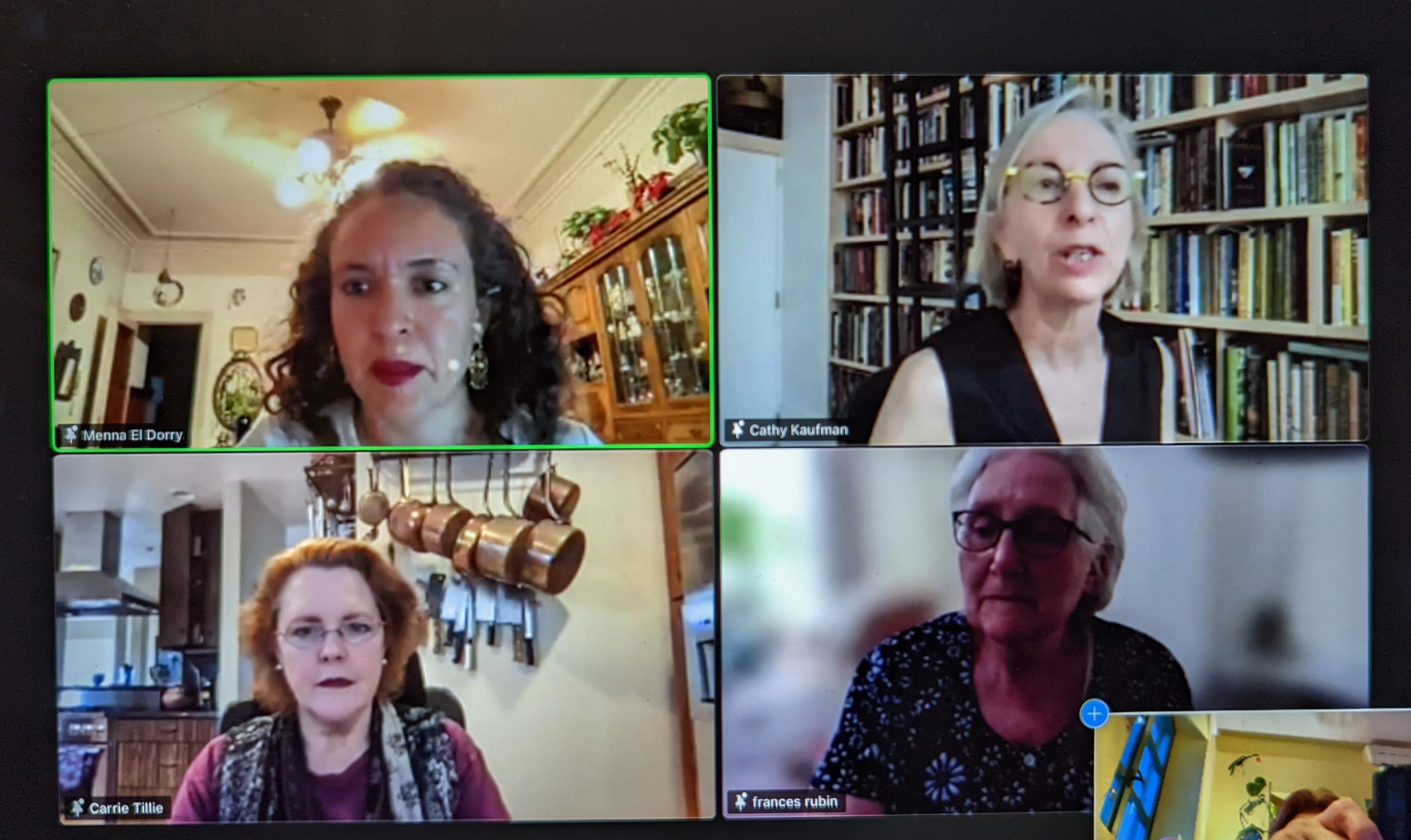
THE SECOND OF SATURDAY AFTERNOON’S PARALLEL SESSIONS on Sugary Treats was hosted by Ken Albala: Marta Manzanares Mileo spoke about the portable sweets Spanish women used to carry in special tied-on pockets. She analyzed sweets’ relation to gender, since in the early years of modern Spain the consumption of confections was used as a means to criticize female gluttony, but also morality in general. Unfortunately, she did not participate in the online session.
Tatsuya Mitsuda examined how and why sweets became portable in late 19th c Japan, their portability bringing about new sets of social appropriateness rules. He also spoke about chocolate candies and other confections imported from the West, which gradually took center stage, becoming more popular than the traditional Japanese sweets. This seems so interesting and bizarre or me, as in the US mochi –the wonderful airy Japanese rice bonbons– are sold in gourmet supermarkets and are extremely popular. They somehow seem to be considered a household name for Americans, and I recently found the word ‘mochi’ used for trivial sweets, obviously to make them attractive, although they had no connection with the irresistible pillowy Japanese rice bites.

AT THE SATURDAY RECEPTION IN THE GARDEN we had the chance to sip a magnificent gin from the Isle of Harris Distillers! Dinner was All Aboard the Darjeeling Express, a real delight! Acclaimed British chef Asma Khan prepared for us a marvelous thali/platter with crunchy Poppadom, Paneer Korma (Indian Cheese Korma), Peela Pulao (Lemon Rice), Masoor Dal (Spiced Red Lentils), Aloo Mattar (Potatoes with Peas in Spiced Cravy), and Tamatar Ki Chutney (Tomato Chutney with Prunes and Apricots). A refreshing Nimbu Pan (Indian Lemonade) was also served, and for dessert we had Sooji Halwa Ladoo (Semolina Halwa Balls with Roses). The wines accompanying the food were 2021 Kamptal Riesling by Fred Loimer, Austria, and a 2017 Samt & Seide Blaufränkisch Prellenkirchen from Dorli Muhr in Carnuntum, Austria. At the end we were served an incredible Rampur Double Cask Indian Single Malt Whisky! Needless to say that the dinner got a standing ovation.
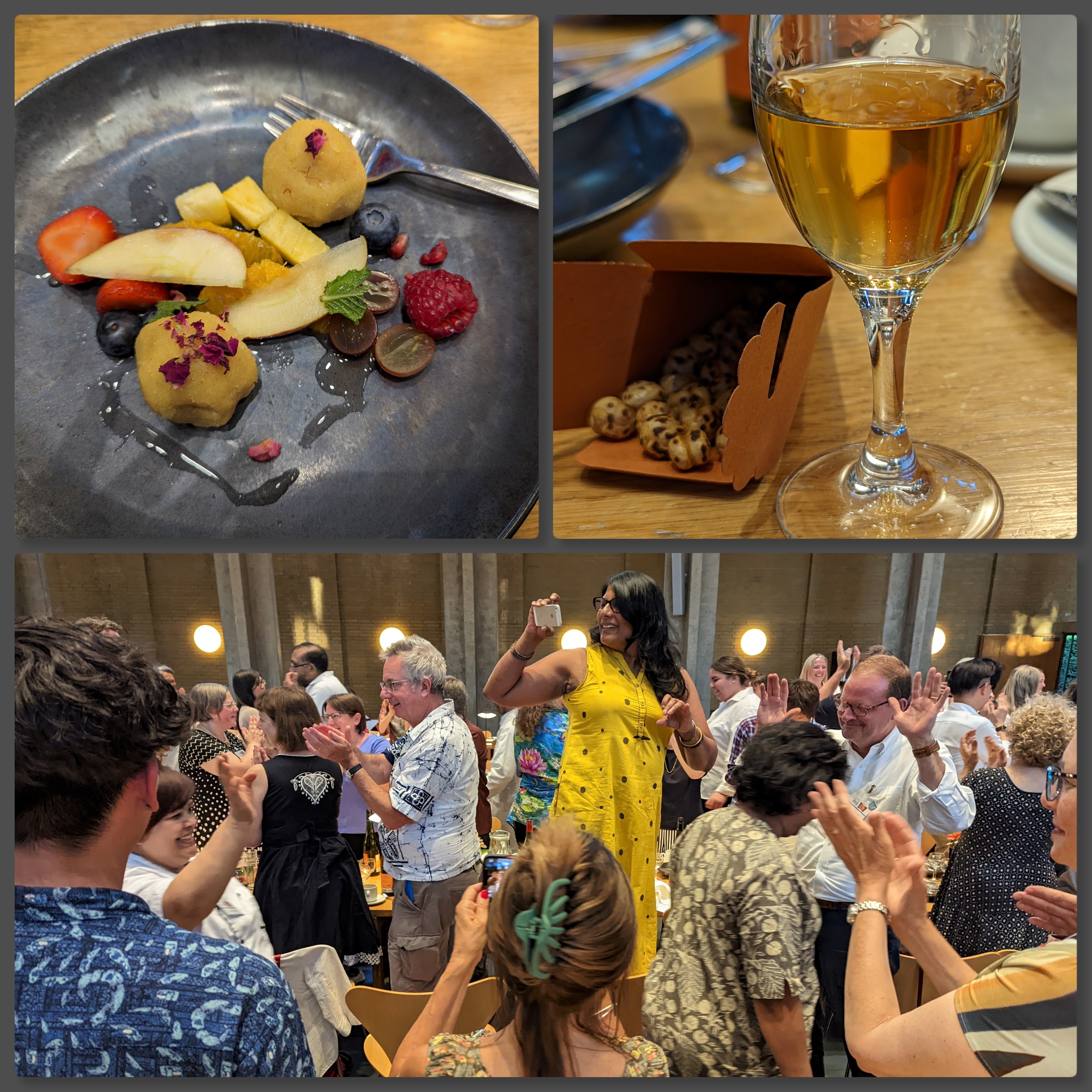
As always, I missed the after-dinner event ‘Wrappit! A Game of Culinary Consequences,’ which was inspired by Ken Albala, and conducted by Elisabeth Luard, since our wonderful artist/graphic designer Jake Tilson couldn’t come, being sick with COVID.

Fortunately, our president, the amazing, tireless Claudia Roden got over her COVID infection in time, and managed to come to Oxford and give her much-awaited keynote speech on Picnic Traditions. Introduced by Gamze Ineceli, the Symposium’s invaluable coordinator of all our meals, Claudia started by comparing French and British sandwiches: Crunchy, noisy, somewhat sloppy, and smelly of garlic and spicy cheese, the baguette sandwiches the French enjoy are the exact opposite to the triangles of crustless white bread the British take with them in their picnics; one cannot even guess what those neatly cut bread slices conceal, she said. This was one of the first things that impressed Claudia when she moved to Britain from Cairo, in the mid-1950s, as Jews and various nationalities were no longer welcome in Egypt. She spoke in detail about her childhood picnics along the Nile, and the basically French dishes she remembers sharing with her family. Then she went on to talk about traditional outdoor eating all over the world, from the Mediterranean to Mexico, stressing, once more, that “food always tastes better outside!” Her pioneering book on picnic food came out in the early 1980’s and has been reprinted many times, most recently in 2012. Her talk was so wonderful that I had to hear it again, in the video, before the discussion during the final online session, on July 31st. Claudia also composed the menu for our wonderful outdoor Sunday lunch (see further down).
SUNDAY’S FIRST OF THE TWO PARALLEL SESSIONS was about Travellers’ Anxieties and washosted by Susan Weingarten. Ken Albala investigated the plethora of dietary tracts from the 15th to the 17th c which were devoted to detailed advice about food choices while traveling. Among other things Albala tried to answer whether the sometimes bizarre food recommendations were actually followed by the travelers. Adi Nahmia Cohen’s research suggested that the Mamluk period Jews (13-16 c CE) in Cairo bought most of their foods already prepared from the market, where Muslim vendors operated as well. Jews were faced with the need and developed methods to ensure that all foods sold to Jews were prepared fully following the appropriate kashrut laws.
SUNDAY’S SECOND SESSION, The Body and the Spirit, was supposed to be hosted by Rick Shepro, but he didn’t make it to Oxford, so Paul Levy hosted the live presentations. Priya Mani spoke very movingly about the elaborate Indian traditions around Food for the Final Journey. She described and showed beautiful pictures of the various foods prepared for dead relatives explaining that the different ingredients and cooking techniques carry special meanings, essential to life and its journey towards the afterlife.
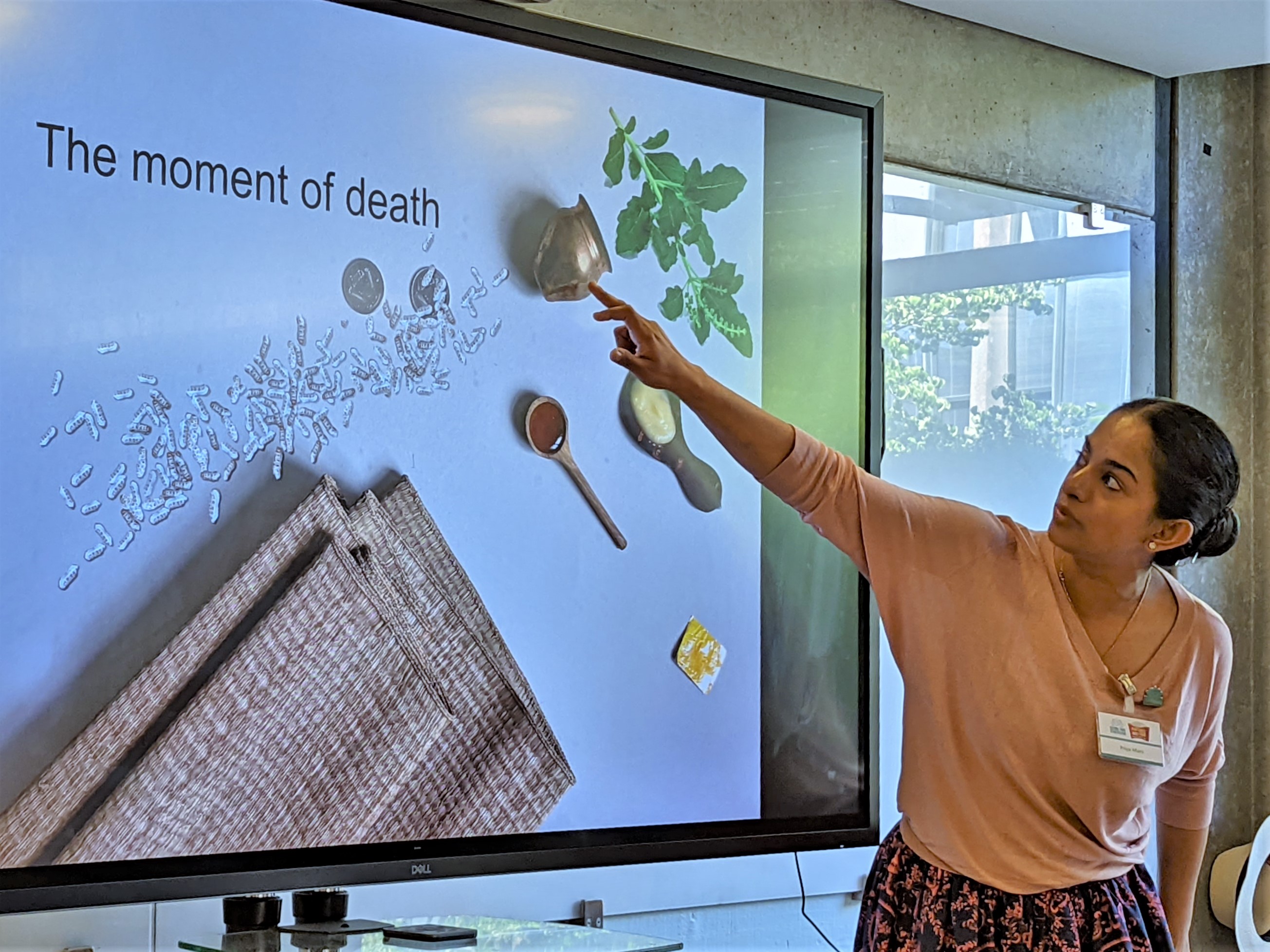
Mazi Kuzi spoke about the Lactating Virgin examining first the image of Virgin breast-feeding Jesus from the 12th c clay depiction in the church of Anzy-le-Duc, in France, comparing it with the image of the lactating Eve from Hildesheim Cathedral in Germany, dated to the first quarter of the 11th c. She reviewed the relationship between Mary and Eve according to medieval theology, citing that “milk in general, of any mother, was believed to affect the moral qualities of the infant.”
AFTER THE COFFEE BREAK, THE PARALLEL SESSIONS CONTINUED with very interesting presentations that described travels By Air and Sea, hosted by Elaine Mahon.Charlotte Kleyn & Aimée Plukker looked at the change in the dishes KLM served to air travelers, and how the company’s menus evolved from the beginning of the first reheated frozen meals in 1947, to the introduction of destination dishes in the 1970s. She also investigated the interplay between national and global foods and their visual representations in KLM’s menus. Andrea Broomfield argued that it was good food and customer service, combined maybe with patriotic pride, rather than the strict stance on safety that attracted early sea passengers. They chose the Atlantic crossing steamers of the American Collins lines that pampered their customers, and abandoned the somewhat spartan, safety-oriented sailing offered by the Canadian/British Cunard.
THE SECOND PARALLEL SESSIONwas on Trail Mixes, hosted at Oxford by Máirtín Mac Con Iomaire,and online by Cathy Kaufman. First-time symposiastC. Thomas Shay, who became one of the most active participants during the various online discussions, described pemican, an indigenous North American portable food. I had never heard the word or knew anything about this foodstuff, so listening to him speaking quite fast, to people who probably knew the term, I had no idea what he was talking about… I had to rush and read his draft paper –I know, I should have done it before—to understand and learn about this ingenious and nourishing traditional food. It combines fish or meat pounded into a pulp –bones, and all– together with sweet berries that probably helps preserve the meat, since no salt is added as it dries completely in the sun. The resulting patties obviously required a long and arduous preparation, but were nutritious, lightweight, and long lasting. Jaime Iram Vargas Barrientos described the foods that sustained the pilgrims of the old Camino Real de Tierra Adentro during the long road on foot or by mule. The characteristics of the foods included high concentrations of fat, salt, and sugar, as well as optimal packaging and processes ensuring that the edibles wouldn’t spoil and would provide sustenance for the long road. Michelle A. Stinson, from a completely different, spiritual perspective, recited Psalms 120-134 from the Hebrew Bible that may have been sung as the Israelites were ascending to Jerusalem with their food offerings, hence the food vocabulary and imagery they entail. She expanded on the idea of ‘portable poetic commensality’ and conviviality, as she imagined people rhythmically reciting the verses while they walked, in a somewhat communal chorus.

SUNDAY LUNCH IS ALWAYS A BITTER-SWEET MOMENT of the Symposium, as it is the last meal we share in Oxford. This time it was actually glorious, since it was compiled by Claudia Roden and we enjoyed her Mediterranean Picnic in the garden, not in the hot and stuffy dining hall. Dishes were prepared by a group of talented young chefs, present and past year’s winners of the OFS Young Chefs grant: Caitriona Nic Philbin, from Ireland, Cordula C.Peters from Germany and UK, Gaurish Shyam from India, and Nia D. Minard from the US. After two years of online discussion about food, they were finally given the chance to cook in Tim Kelsey’s amazing kitchen, under his thoughtful guidance that ensures that all meals we get during the weekend are beyond excellent!
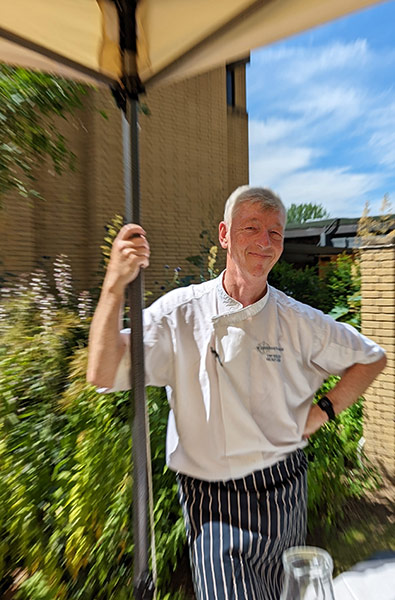
We had Gazpacho Andaluz, Mediterranean Nibbles –hardboiled eggs with aioli, cherry tomatoes, and baby cucumbers– and the most delicious Chicken Wrap, inspired by Palestinian Musakhan. For the vegetarians there was a Wrap of Aubergines (eggplants) and Peppers with Chickpeas in a spicy thick Tomato Sauce. Needless to say, most of us ate both wraps, something Claudia said she had anticipated. For dessert we had a refreshing Sangria Jelly, made with port, brandy, and wine, topped with fresh fruit, along with Amandines, the crunchy-soft almond pastries Claudia learned to make from a village bakery at Lumieré, in Provence. A lovely 2020 Rosé, again from Dorli Muhr from Austria accompanied our meal.
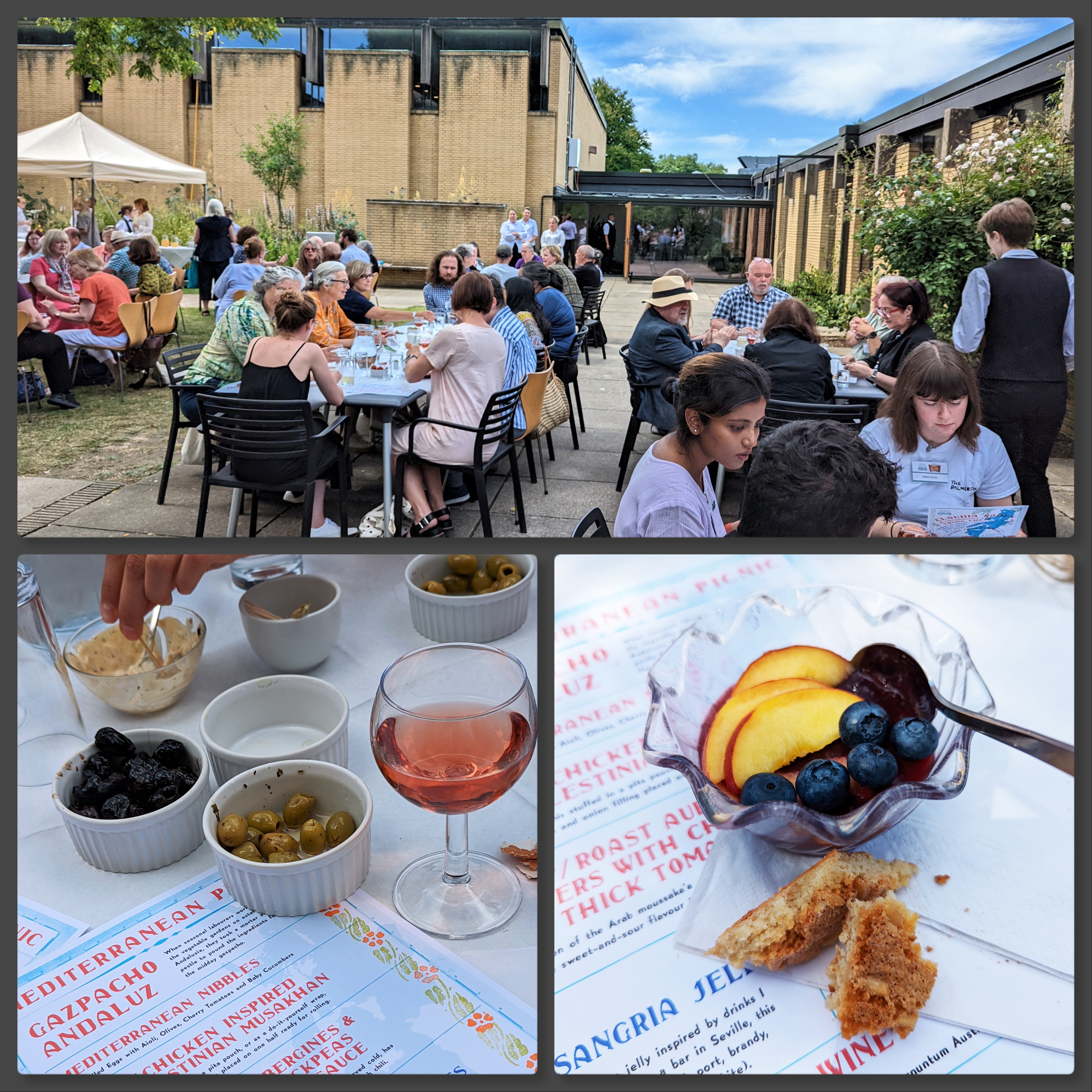

Online Only
The following groups include the papers delivered by Symposiasts who only participated in the Zoom sessions, or at the last moment chose not to come to Oxford. We watched the pre-recorded videos and followed the discussions with the presenters, as we did with the papers we heard during the live sessions.
A DIVERSE, STIMULATINGsession about Migrations was hosted by Priya Mani. Tamar Babuadze showed wonderful photos of old Tbilisi and discussed how political change in Georgia has affected the lively traditional forms of urban picnics and public feasting in the country’s capital. Hennie Fisher’s very intriguing descriptions of Bunny Chow, an iconic portable food of South Africa, made me want to make it with my own bread, something that probably would not do at all. Fisher tried to trace the obscure and contradictory historical threads of Bunny Chow which consists of soft, supermarket bread stuffed with a rich and flavorful mixture of curry. Binti Gurung explored the culture of koseli, the Nepali edible gifts. The focus was on various caste, religious, and ethnic factors involved.
THREE VERY INTERESTING TALKS about Street Foodswere hosted by chef/author Cameron Stauch. Serkan Çelik & Sinem Akman explored the world of Çiğ köfte, the Turkish spicy raw meat patties, a food that few travelers have tasted, and so far has not been much studied. Serkan discussed its history and evolution throughout the various social classes, and explained how it became a portable food, prepared by especially skilled cooks who were hired to make Çiğ köfte in social gatherings. He said that its preparation has now almost stopped, as consumption of raw meat is somewhat prohibited in Turkey. Similar-looking patties are now made with bulgur. Pırıl Kadırgan spoke about dolma and/or sarma, the rice-and-herb stuffed vine leaves, which used to be a practical portable street food, a favorite during open air gatherings in Istanbul during the last period of the Ottoman Empire. Of course, the time-consuming dolma/sarma have now been replaced by Midye dolma (stuffed mussels) on Istanbul streets, as these are much easier to prepare. Ayari G. Pasquier Merino & Maria Fernanda’s study, carried in the Autonomous University of Mexico campus, addressed the cultural meaning surrounding the sale and consumption of tacos de canasta (tacos from the basket) in relation to the various socio-economic factors involved in the process of selling warm tacos in the streets. As Cameron pointed out there is now a Lady Tacos in a much-discussed Nettflix series.
IN POLITICS AND ACTIVISM, a session hosted by Anne Urbancic, Michael Johnson presented an account of the Chicken Sandwich Wars, brought about by the introduction of fried chicken sandwiches by competing fast-food chains. He explored the efforts of these restaurants to gain more customers who would be persuaded to insert more fast-food meals in their lives, especially during the COVID-19 pandemic period, when money was tight. Freda Muyambo, used as an example the uprising after the killing of unarmed protesters on October 20, 2020 in Lagos, Nigeria, during theEnd SARS protests against police brutality, amid the coronavirus pandemic. She spoke about the various chefs who cooked, packaged, and delivered food to the protesters to keep the movement going, and reflects on the issue of weaponizing starvation as a tactic of war.
CONQUEST AND CONFLICT was hosted by Margie Gibson. Johanna Mendelson Forman’s paper explored how An Army Marches on Its Stomach, reviewing the history of portable meals and how these evolved with the help of new technologies. Important changes and improvements were the result of efforts to develop better military food, but also as various organizations tried to feed large groups of people in humanitarian emergencies, she said. Jacqui Newling detailed the ways in which colonists from different social tiers cooked and dined, often with limited resources and rudimentary facilities. She suggested that contrary to what is commonly thought, early settlers have not always been as dependent on imports as it is generally believed. Based on their own inventiveness and sensibilities, colonists often adjusted their food habits to the local conditions. Diana Noyce compared the different tactics Amundsen and Scott used in conquering the Pole. She suggested that Amundsen succeeded because he used more reliable transport, and better food, compared with Scott who seemed to be tied to less flexible expedition tactics.
IN DEFINING IDENTITIES, hosted by Naomi Guttman, long-time symposiast Anthony F. Buccini, who usually explores ancient Rome and Greece, this year focused on contemporary Chicago’s “Italian beef” sandwiches. He traced the Neapolitan roots of cooking beef with savory and sweet spices, very differently from the usual pastrami or BBQ beef slices common in sandwiches all over the US. He concluded that today’s version of the Chicago beef is a commercial adaptation of an old festive dish, that had its origins in very old traditional methods of cooking brought to the US by southern Italian immigrants from the Naples area. Peter Hertzmann in his Fair Food to Walk With discussed the various foods offered at American fairs, focusing on walking-around food consumed while moving from one exhibit to the next. Meher Mirza gave a fascinating account of the old Parsi collective festivals, known as gahambar. After discussing their original forms, she lamented on how they have been transformed through time, from their initial pastoral agricultural Zoroastrian roots to today’s urban gahambars of the diasporic communities that require guests to purchase tickets, thus isolating the event to a higher socioeconomic group.
Birgitte Kampmann organized yet one more, truly inspired Zoom Kitchen Lab, on Sunday, July 17. Her co-hosts were Elisabeth Luard, who taught us how to prepareSpanish Empanadas, sharing her recipe for the most wonderful olive oil pastry! Symposium’s trustee Gamze Ineceli, who brilliantly coordinates all our meals in Oxford, introduced the Turkish researcher and baker Ayfer Yavi who prepared the most wonderful Gözleme, making the traditional dough, rolling phyllo, and baking the pastries on the Sač.
We also observed science buff, symposiast Len Fisher as he spoke and demonstratedthe Perfect Proportion of Cheese in the British cheese sandwich.
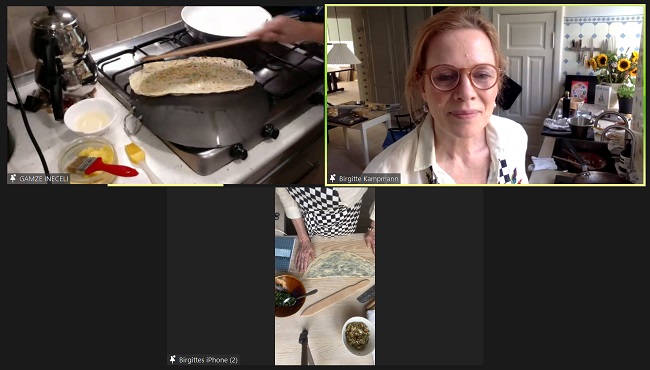

UNLIKE WHAT USED TO HAPPEN ON SUNDAY AFTERNOON during our gatherings at Oxford, this year we did not choose the theme for the 2025 conference then. The proposals of themes and the final voting were held during the closing session of the online Symposium, in the end of July. So, we skipped the lively, somewhat chaotic discussions, arguments and multiple counting that usually concludes the Symposium, and this year’s live meeting ended “not with a bang but a whimper,” somewhat quietly with Cathy Kaufman’s weekend sum up.
But on the 31st of July, as we all gathered through Zoom, we experienced moments of the old live atmosphere, guided, as always, by Mark McWilliams. We frantically wrote in the chat and discussed with friends, old and new, in the various sub-groups David Matchett, our master of online ceremonies, divided us. I was trying to convince people to vote for Food and Memory, but in the end Food and Elements was chosen; a very interesting and accommodating theme, I believe.
We parted after a first glimpse of Jake Tilson’s brilliant logo for next year’s Symposium: Food Rules and Rituals and were very pleasantly surprised by the triumphant chords of Mozart’s Cosi Fan Tutte. David, also the Symposium’s resident DJ, delights and amazes us with the diverse pieces of music he chooses for each session’s opening and closing, enhancing the mood, and very often introducing — at least to me– completely new and unexpected pieces, like the uplifting, addictive Wellerman for Lizzie Collingham’s keynote, which I kept listening to for almost a week…
